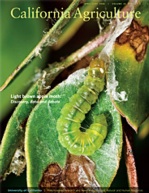All Issues

Light brown apple moth: Discovery, data and debate
Cover:
Methods for controlling the light brown apple moth - a pest insect from Australia that was discovered in California last year - include mating disruption, insect growth regulators, and natural parasites and predators. Found in Santa Cruz County, this larva has a white oval on the right side of its head that is a parasitic fly's egg. Photo: Jack Kelly Clark
April-June 2008
Volume 62, Number 2
Volume 62, Number 2





